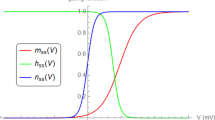Summary
The maximum potential displacement that gives a linear K conductance response was determined to be 1 mV (rms) from a voltage-clamp analysis of TTX treated axons. For perturbations below this amplitude the K conductance kinetics are indistinguishable from a first-order rate process. Linearity and order of kinetics were assessed by four types of measurements: (i) the shape of the onset of the potassium current (sigmoidalvs. exponential); (ii) the symmetry of small hyperpolarizing and depolarizing pulses, (iii) wide band admittance, and (iv) harmonic analysis. The simplest interpretation of the results is that the small-signal linear response arises from a first-order gating mechanism, whereas the large-signal conventional voltage-clamp pulse of tens of millivolts evokes nonlinear phenomena. The small-signal results are consistent with the Hodgkin-Huxley description or any other nonlinear model which fits the large signal data and produces a linear first-order response for small perturbations.
Similar content being viewed by others
References
Armstrong, C.M., Bezanilla, F. 1977. Inactivation of the sodium channel. I. Sodium current experiments.J. Gen. Physiol. 70:549
Cole, K.S., Baker, R.F. 1941. Longitudinal impedance of the squid giant axon.J. Gen. Physiol. 24:535
Cole, K., Moore, J.W. 1960 Ionic current measurements in the squid giant axon membrane.Biophys. J. 1:1
Eigen, M. 1968. New looks and outlooks on physical enzymology.Q. Rev. Biophys. 1:3
Fishman, H.M. 1973. Relaxation spectra of potassium channel noise from squid axon membrane.Proc. Nat. Acad. Sci. USA 70:876
Fishman, H.M. 1975. Rapid complex impedance measurements of squid axon membrane via input-output crosscorrelation function.In. Proceedings of the First Symposium on Testing and Identification of Nonlinear Systems. G.D. McCann and P.Z. Marmarelis. editors. pp. 257–274. California Institute of Technology. Pasadena
Fishman, H.M., Poussart, D.J.M., Moore, L.E., 1979. Complex admittance of Na+ conduction in squid axon.J. Membrane Biol. 50:43
Fishman, H.M., Poussart, D.J.M., Moore, L.E., Siebenga, E. 1977. K+ conduction description from the low frequency impedence and admittance of squid axon.J. Membrane Biol. 32:255
Frankenhaeuser, B., Hodgkin, A.L., 1956. The action of calcium on the electrical properties of squid axons.J. Physiol. (London) 137:217
Grisell, R., Fishman, H.M. 1979. Analysis of models applicable to the low frequency impedance of squid axon.J. Membrane Biol. 46:1
Hodgkin, A.L., Huxley, A.F. 1952. A quantitative description of membrane current and its application to conduction and excitation in nerve.J. Physiol. (London) 117:500
Keynes, R.D., Rojas, E. 1976. The temporal and steady state relationships between activation of the sodium conductance and the movement of gating particles in the squid giant axon.J. Physiol. (London) 255:157
Matsumato, N., Inoue, I., Kishimoto, U. 1970. The electric impedance of the squid axon membrane measured between internal and external electrodes.Jpn. J. Physiol. 20:516
Moore, L., Holt, J., Lindley, B. 1972. Laser temperature-jump technique for relaxation studies of the ionic conductance in myelinated nerve fiber.Biophys J. 12:157
Moore, L.E., Jakobsson, E. 1971. Interpretation of the sodium permeability changes of myelinated nerve in terms of linear relaxation theory.J. Theor. Biol. 33:77
Neumcke, B., Nonner, W., Stämpfli, R. 1976. Asymmetrical displacement current and its relation with the activation of sodium current in the membrane of frog myelinated nerve.Pfluegers Arch. 363:193
Offner, F.F. 1972. The excitable membrane. A physiochemical model.Biophys. J. 12:1583
Palti, Y., Ganot, G., Stämpfli, R. 1976. Effect of conditioning potential on potassium current kinetics in the frog node.Biophys. J. 16:261
Poussart, D., Ganguly, U.S. 1977. Rapid measurement of system kinetics-an instrument for real-time transfer function analysis.Proc. IEEE 65:741
Poussart, D., Moore, L., Fishman, H. 1977. Ion movements and kinetics in squid axon. I. Complex admittance.Ann. N. Y. Acad. Sci. 303:355
Roy, G. 1975. Basic experimental facts on ionic currents in excitable membranes.Prog. Biophys. Mol. Biol. 29:57
Stevens, C.F. 1972. Inferences about membrane properties from electrical noise measurements.Biophys. J. 12:1028
Van Kampen, N.G. 1965. Fluctuations in nonlinear systems.In: Fluctuation Phenoma in Solids. R.E. Burgess. editor. pp. 139–177. Academic Press. New York
Author information
Authors and Affiliations
Rights and permissions
About this article
Cite this article
Moore, L.E., Fishman, H.M. & Poussart, D.J.M. Small-signal analysis of K+ conduction in squid axons. J. Membrain Biol. 54, 157–164 (1980). https://doi.org/10.1007/BF01940569
Received:
Issue Date:
DOI: https://doi.org/10.1007/BF01940569




